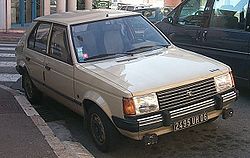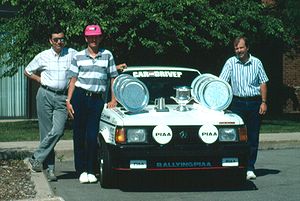- Chrysler Horizon
-
Chrysler/Simca/Talbot Horizon 
Manufacturer Chrysler Corporation
PSA GroupAlso called Simca Horizon
Talbot HorizonProduction 1977–1986 Predecessor Simca 1100 Successor Peugeot 309 Class Subcompact Body style 5-door hatchback Layout FF layout Platform L-body Engine 1.1 L I4
1.3 L I4
1.5 L I4
2.2 L I4
1.9 L diesel I4Related Dodge Charger
Dodge Omni
Dodge Omni 024
Dodge Rampage
Plymouth Horizon
Plymouth Horizon TC3
Plymouth Scamp
Plymouth Turismo
Simca Alpine
Shelby GLH-S and Charger GLH-SThe Horizon was a subcompact automobile (or supermini) developed by Chrysler Europe and was sold in Europe between 1977 and 1985 under the Chrysler, Simca and Talbot nameplates. A derivative version of the Horizon was also built in the United States under the Dodge and Plymouth marques until 1990.
Contents
Origins
The Horizon was designed by Simca, the French division of Chrysler Europe in the 1970s and introduced in 1977. It survived in various guises until 1990. In France it was initially sold under the Simca brand, whilst elsewhere in Europe it was initially badged as a Chrysler. As a result of the acquisition of Chrysler's European car division by Peugeot in 1978, both the Chrysler and Simca brands were dropped and the car was then sold under the Talbot brand in all its European markets.
The Horizon, or Project C2 as it was known inside Simca during development, was intended to be a "world car", meaning that it was designed for consumers on both sides of the Atlantic, but in execution, the European and North American versions of the vehicle actually turned out to have very little in common.
Born largely out of the need to replace the ageing Simca 1100, the Horizon was essentially a shortened version of the larger Alpine model, giving the vehicle an unusually wide track for its length. Featuring the familiar range of Simca-designed 1.1, 1.3 and 1.5 L OHV engines, and torsion-bar suspension, the Horizon gained praise for its crisp styling, supple ride, and competent handling. It was voted European Car of the Year in 1979. Its launch saw to the end of the 1100 and the rear-engined Simca 1000.
The Horizon was the first British-built hatchback of this size — launched two years before the Vauxhall Astra, three years before the European Ford Escort Mark III and five years before the Austin Maestro. It did not officially replace any of the British Chryslers, despite being a similar size to the traditional rear-wheel drive Avenger saloon and estates which had been on sale since 1970 and did not finish production until 1981.
North American variants — "Omnirizon"
The North American versions of the Horizon were known as the Dodge Omni and Plymouth Horizon. Although they appeared to share the same external panelwork as the European Horizon (the panels were in fact not interchangeable), they were vastly different mechanically — using a larger engine (of VW, then PSA origins on the early versions, replaced by Chrysler's own 2.2L OHC "Trenton" I-4 later) and MacPherson strut suspension at the front instead of the more complex torsion bar arrangement. They also sported much heavier looking (though actually aluminum) bumpers so as to comply with stricter US safety legislation. Despite the car's European origins, then Chrysler chairman Lee Iacocca played this down, emphasizing that features such as the trip computer and electronic ignition were of American design.
In the US, many variants were eventually produced, including 2-door versions ("Charger" and "TC-3 / Turismo"), econo versions ("America", "Miser"), and powered-up versions such as the GLH, GLH Turbo, and Shelby GLH-S (turbo, intercooled, 174 bhp). Even a small pickup truck was based on the Horizon ("Scamp" and "Rampage"). Some of these cars had successful careers in racing venues such as Auto-X, road and endurance racing, and pro rallying.
Production life
In Europe, the Horizon had a turbulent existence. The collapse of Chrysler Europe in 1978 and its subsequent sale to Peugeot meant that the car was hurriedly rebadged using the exhumed Talbot brand for the remainder of its life. The Horizon was initially built in the former Simca factory in France but from 1980 production expanded to the former Chrysler Europe Ryton plant, near Coventry in England.[1]
In 1981, Series II models were introduced, with some minor improvements. By then however, the Horizon was becoming increasingly uncompetitive next to rivals such as the Volkswagen Golf, Opel Kadett/Vauxhall Astra and the third generation Ford Escort. The rattly and unrefined ohv engines which had been carried over from the Simca 1100 were largely to blame, while body corrosion was a serious issue, at least until Series II, giving many cars a short service life.
The series two Horizon launched in 1983 had a 5 speed gearbox, and badged series II 5 speed. The bumpers were painted black and the rear windscreen was smaller, because the parcel shelf was raised to increase the size of the boot. Some models had an electronic LED 'econometer' which lit up several lights around the edge of the speedometer dial, There was also an LED tachometer on top of the range models which was a row of green,yellow and red LEDs and was positioned atop the steering column.
The Horizon was then updated in 1985, with different interior trim again slight changes to instrument dials and door cards were to make the car look more modern. Fewer paint colours were available and fewer models. Many of the late cars (built between 1985–1987) were painted in an un-sympathetic pale green or cream. Horizons had initially been available in more adventurous colours including orange, but the 1970s era had passed.
A Talbot Horizon turbo concept car was produced in 1984 with a full cream leather interior and sporty body kit, the car was designed at the Whitley design centre, Coventry. The Turbo Horizon is very different to those models once seen out on the street and is kept at Coventry Transport Museum, Coventry England.
Due to corrosion problems there are few left, Horizon is now a rare sight with possibly less than 200 surviving examples in the UK.
The main production lines of Talbot Horizon were Poissy factory in France and Ryton in England. It was also manufactured in Spain and in Finland by Saab-Valmet from 1979 onwards. The Finnish Talbot Horizons integrated many Saab components, especially in the interior. The Saab-Valmet factory also made a series of 2385 cars that ran on kerosene or turpentine.
The Horizon was produced in France and also Britain (where production had begun in the 1980s) until the end of 1985, and in Spain and Finland until 1987, when it was replaced by the Peugeot 309, a car developed in the UK, originally destined to be sold as the Talbot Arizona. The end of Horizon production in 1987 also marked the end of the Talbot badge on passenger cars. However, the North American version of the car continued to be produced until 1990.
The PSA XUD9 diesel engine of 1905 cc diesel engine was fitted to certain models of the Horizon, which was the first example of this engine available in the UK. All UK diesel Horizons were made in Spain. The Peugeot-Talbot brochure of October 1984 shows the only diesel Horizon being the LD1.9, the XUD9 engine only available in the Peugeot 305 GRD as well. The Horizon was not the first diesel in the Talbot family of cars with the Chrysler 180 in Spain being powered by diesel.
The Peugeot 309 continued to use the Horizon range of Simca based engines in early life, until replaced with the more modern Peugeot TU engine in 1992.
Horizon in the UK
In Britain, it was seen as a modern alternative to the existing Rootes-designed Avenger models, offering buyers a front-wheel drive hatchback alongside the rear-wheel drive saloon. The Avenger was produced alongside it until 1981.
UK sales of the Horizon (which went on sale there in early 1978 and was badged as a Chrysler until 1 August 1979, when it became a Talbot) were initially quite strong, but within five years of its launch it was starting to lose sales in a segment dominated by an increasing number of newer models including the Ford Escort Mark III, Vauxhall Astra, Austin Maestro and Volkswagen Golf Mark II.
The last British Horizons were sold in 1986, soon after the launch of Peugeot's Ryton-built 309 which had originally been intended for sale as the Talbot Arizona, as a Talbot-branded successor to the Horizon, and went on sale in January 1986. The 309 continued the Simca heritage by using Simca-derived engines in its smaller models.
The Ryton factory remained open until December 2006.
UK Specifications range
Capacity 1118–1905 cc Power 59–90 hp Max. speed 147 km/h (91 mph) – 175 km/h (109 mph) Acceleration 0–60 mp/h: 17.9–11.4 seconds Models
The UK Horizon was available as the following versions:
- 1100 GL
- 1100 GLE
- 1300 GL
- 1300 LS
- 1300 LX
- 1300 GLX
- 1500 LS
- 1500 GLS
- 1500 SX auto
- 1900 LD
Most models were available with 4 or 5 speed gearboxes, which were initially a carry-over of the simca gearbox, and then later the PSA BE gearbox. Automatic transmission was available on most 1500 models, and was standard equipment on the 1500 SX model.
Some limited editions were:
- 1500 "Pullman" top of range model. This had upmarket trim and a design of alloy wheel similar to the Lotus Sunbeam and a wider tyre. The Pullman also had radio upgrade with 4 speakers, and rear seatbelts. Most had beige over brown metallic, two-tone paintwork. Around 20% of the Pullman models were two tone silver and blue.
- 1300 "Summertime Special" This had red plastic trim in place of the usual black.
- 1500/1300 "Ultra" (1985)an upmarket high-spec car in silver metallic, had its name 'ULTRA' on the front wings in black lettering. Ultra had grey velour interior with red piping.
- 1500 "Silver Fox" which had two tone paintwork half silver, half blue metallic.
References
External links
Categories:- Chrysler vehicles
- Front wheel drive vehicles
- Subcompact cars
- Hatchbacks
- 1970s automobiles
- 1980s automobiles
- Vehicles introduced in 1977
Wikimedia Foundation. 2010.


